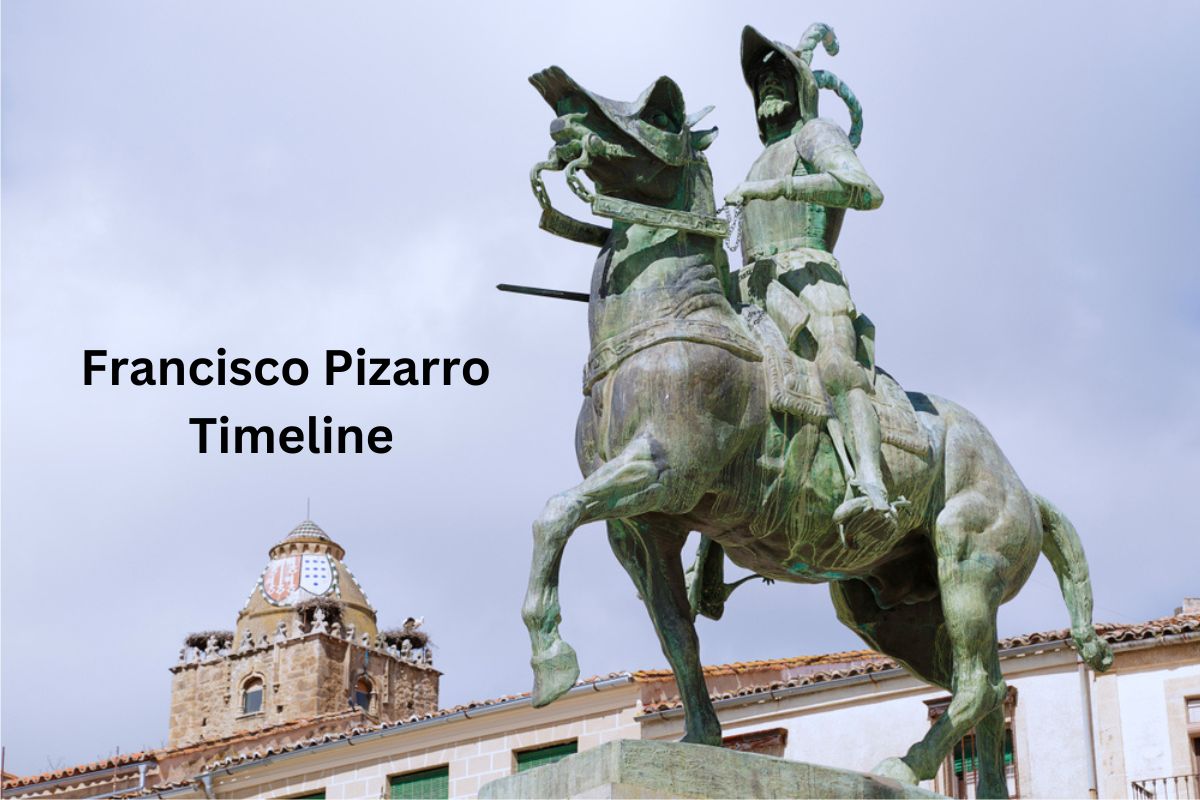Francisco Pizarro (c. 1471 – 1541) was a Spanish conquistador and explorer who played a pivotal role in the conquest of the Inca Empire, leaving an indelible mark on the history of South America.
Born in Spain, Pizarro embarked on several expeditions that ranged from early explorations to his later conquests, ultimately leading to the downfall of the powerful Inca civilization.
His founding of cities, such as Cusco and Lima, contributed to the Spanish colonization of the region.
However, his complex interactions with indigenous peoples, fellow conquistadors, and the tragic conflicts that ensued reveal a multifaceted legacy that shaped the course of history in the New World.
| Year | Event |
|---|---|
| 1471 | Francisco Pizarro is born in Trujillo, Extremadura, Spain. |
| 1513 | Accompanies Vasco Núñez de Balboa’s expedition to the Pacific Ocean. |
| 1524 | Leads unsuccessful expedition to explore and conquer the Inca Empire. |
| 1532 | Returns to Peru, captures Inca ruler Atahualpa at the Battle of Cajamarca. |
| 1533 | Establishes the city of Cusco as the capital of the conquered territory. |
| 1535 | Founds the city of Lima, the new capital of Spanish Peru. |
| 1538 | Conflict with Diego de Almagro over territorial claims and power struggles. |
| 1539 | Half-brother Hernando Pizarro’s expedition to the Amazon for El Dorado. |
| 1541 | Assassinated by conspirators in his palace in Lima. |
Timeline of Francisco Pizarro
1471 – Francisco Pizarro is born in Trujillo, Extremadura, Spain
Francisco Pizarro is born in Trujillo, Extremadura, Spain. Little is known about his early life, but he grew up in a relatively humble background and had limited formal education. He eventually joined the Spanish military and gained some experience in the New World.
1513 – Accompanies Vasco Núñez de Balboa’s expedition to the Pacific Ocean
Pizarro accompanies Vasco Núñez de Balboa’s expedition to the Pacific Ocean. This journey marked a significant moment in European exploration as they became some of the first Europeans to lay eyes on the Pacific Ocean from the Americas.
Also Read: Facts About Francisco Pizarro
The expedition involved crossing the Isthmus of Panama, which was a challenging and arduous journey through dense jungles and rugged terrain.
1524 – Leads an unsuccessful expedition to explore and conquer the Inca Empire
Pizarro, along with his partner Diego de Almagro and a small group of men, embarks on an expedition to explore and conquer the Inca Empire.
This endeavor was initially unsuccessful due to various hardships, conflicts with indigenous populations, and a lack of resources. The expedition returned to Panama, having achieved little success.
1532 – Captures Inca ruler Atahualpa at the Battle of Cajamarca upon returning to Peru
Pizarro returns to Peru with a more prepared and better-equipped force. At the Battle of Cajamarca, Pizarro’s forces, numbering around 160 men, capture the Inca ruler Atahualpa. This event was a turning point in the conquest of the Inca Empire.
Despite Atahualpa offering a room filled with gold and silver as ransom, Pizarro eventually orders his execution, which further weakened the Inca resistance and paved the way for Spanish colonization.
1533 – Establishes the city of Cusco as the capital of the conquered territory
After capturing Atahualpa, Pizarro establishes the city of Cusco as the capital of the newly conquered Inca territory. Cusco had been the historic capital of the Inca Empire, and Pizarro’s decision to make it the capital of Spanish Peru demonstrated his strategic understanding of the region’s importance.
1535 – Founds the city of Lima, the new capital of Spanish Peru
Pizarro founds the city of Lima on the Pacific coast of Peru. Lima was strategically located as a port city and provided easier access to the sea, facilitating trade and communication with Spain. The city quickly grew and became a significant center of Spanish influence in the Americas.
1538 – Engages in conflict with Diego de Almagro over territorial claims and power
Conflict emerges between Pizarro and his former partner, Diego de Almagro, over territorial claims and the distribution of spoils from the conquest.
This dispute leads to armed conflict known as the “Battle of Las Salinas,” during which Pizarro’s forces defeat and capture Almagro. Almagro is later executed by Pizarro’s orders.
1539 – Half-brother Hernando Pizarro leads an expedition to the Amazon in search of El Dorado
Pizarro’s half-brother, Hernando Pizarro, leads an expedition into the unexplored Amazon rainforest in search of the legendary city of El Dorado.
This quest for riches and legendary cities was a common theme during the Age of Exploration, but like many similar endeavors, it yielded limited success and faced numerous challenges in the harsh Amazon environment.
1541 – Assassinated by conspirators in his palace in Lima
As tensions continue to rise, a group of conspirators led by Almagro’s supporters assassinates Francisco Pizarro in his palace in Lima. This act of violence marks the end of Pizarro’s life and leadership.
The assassination highlighted the volatility and power struggles that characterized the early days of Spanish colonization in the Americas.
These events collectively showcase Francisco Pizarro’s role as a conquistador, explorer, and founder of cities in the Spanish territories in South America. His actions had a profound impact on the history and culture of the region, shaping the course of Spanish colonization and its lasting effects on the indigenous populations.
